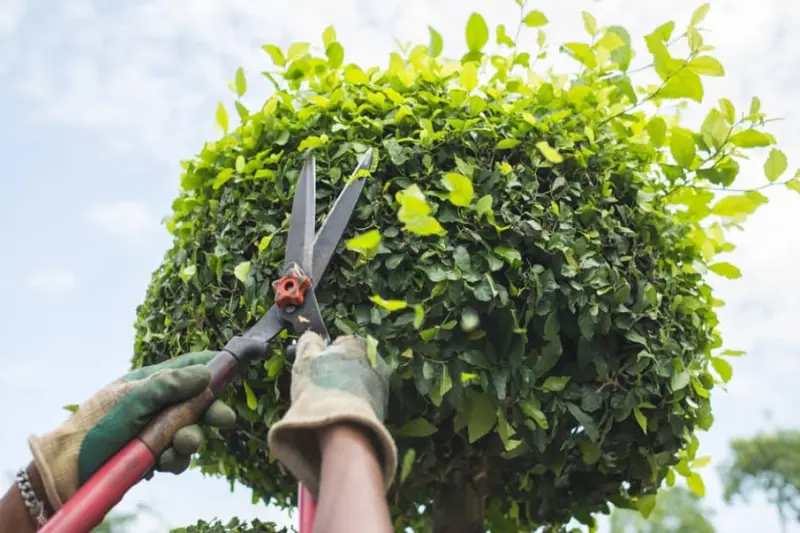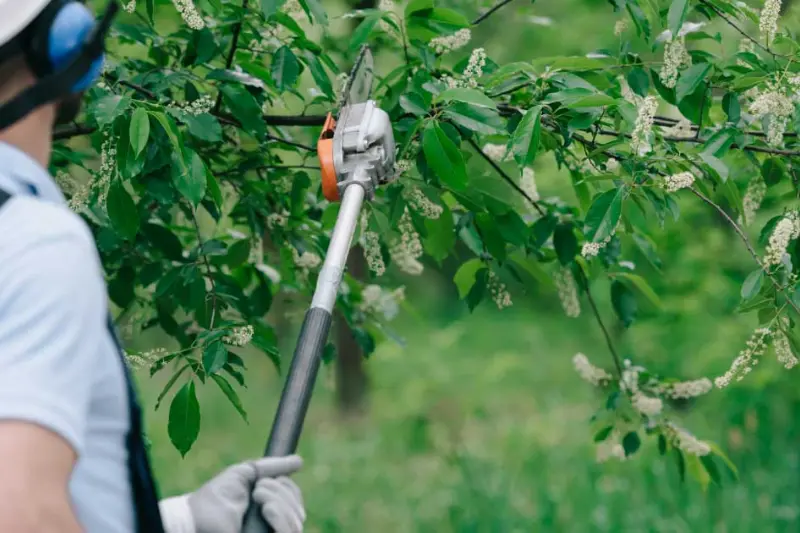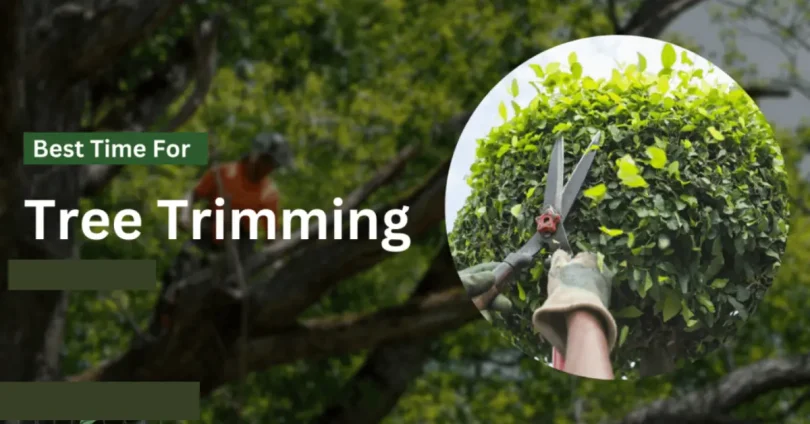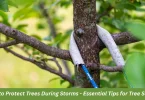Introduction
Taking care of trees goes beyond just watering them. One of the most important parts of tree care is trimming, and knowing when to trim makes a big difference. In this blog, “Best Time to Trim Trees – Seasonal Guide for Healthy Growth,” you’ll learn how each season affects your trees and the ideal time to prune them. Trimming trees at the right time helps them grow stronger, stay healthy, and look great all year round. Whether you’re new to tree care or just need a refresher, this simple seasonal guide will make tree trimming easy to understand and do right.
What is the Best Time to Trim Trees?

The best time to trim trees usually depends on the type of tree and your reason for trimming. In general, the ideal time for most trees is late winter to early spring, when the trees are still dormant but about to start growing again. During this time, trimming causes less stress and allows the tree to heal quickly as it enters its growing season.
However, light trimming or removing damaged branches can be done any time of the year. Just avoid heavy pruning in late spring or early fall, as it may weaken the tree or interrupt its natural growth cycle.
Key Point:
- Late winter to early spring = Best for most trees
- Summer = Okay for minor shaping
- Fall = Avoid heavy trimming
- Winter = Great for major pruning (when trees are dormant)
Why Knowing the Best Time to Trim Trees Is Important
Promotes Healthy Growth
- Encourages strong branch structure: Trimming at the right time helps guide how branches grow, leading to a healthier, more balanced tree.
- Reduces stress on the tree: Pruning during dormancy lets the tree heal before active growth begins in spring.
- Prevents overgrowth and crowding: Regular trimming avoids tangled branches and improves airflow through the canopy.
Helps Prevent Diseases and Pests
- Avoids open wounds during risky seasons: Trimming at the wrong time can leave trees vulnerable to infections or decay.
- Limits insect exposure: Pests are less active in late winter, so fresh cuts are less likely to attract bugs.
- Stops spread of fungal diseases: Some fungi spread more easily in warm, moist conditions—timing can reduce this risk.
Improves Safety and Appearance
- Removes weak or dead branches: These can fall and cause injury or damage, especially during storms.
- Shapes the tree for better structure: Trimming keeps the tree looking neat and encourages balanced growth.
- Protects buildings and power lines: Controlling branch growth prevents interference with nearby structures or wires.
Step-by-Step Guide: Best Time to Trim Trees

Step 1: Identify the Type of Tree
- Different trees have different trimming needs.
- Know if your tree is deciduous (loses leaves) or evergreen, fruit-bearing or ornamental.
Step 2: Understand the Tree’s Growth Cycle
- Most trees are best pruned during dormancy (late winter to early spring).
- Learn your tree’s seasonal patterns to avoid trimming during growth spurts or flowering.
Step 3: Choose the Right Tools
- Use sharp, clean pruning shears, loppers, or a pruning saw.
- Sanitizing your tools helps prevent spreading diseases between trees.
Step 4: Inspect the Tree Carefully
- Look for dead, diseased, or damaged branches to remove first.
- Also check for branches crossing or rubbing against each other.
Step 5: Start with Light Trimming
- Begin by cutting small, obvious problem branches.
- Avoid cutting more than 25% of the tree’s branches at once.
Step 6: Shape the Tree Thoughtfully
- Maintain a natural shape that balances the tree’s weight.
- Trim branches growing inward or downward for better structure.
Step 7: Clean Up and Dispose Properly
- Remove all trimmings from the ground to avoid attracting pests.
- Compost or dispose of branches according to your local guidelines.
Step 8: Monitor the Tree After Trimming
- Watch for signs of stress or disease in the days and weeks after.
- Water the tree if needed and avoid fertilizing immediately after heavy pruning.
Advantages and Disadvantages of Trimming Trees at the Right Time
| Advantages | Disadvantages |
| Encourages Healthy Growth When trimmed during the correct season, trees respond with stronger and more balanced growth. | Can Stress the Tree Trimming during growth or flowering seasons can put unnecessary stress on the tree. |
| Prevents Diseases and Pests Seasonal pruning helps reduce the risk of infections and pest infestations that can harm the tree. | Increases Risk of Disease Open wounds made at the wrong time may not heal well and can attract fungi or bacteria. |
| Improves Tree Structure and Appearance Pruning at the right time maintains a well-shaped tree and reduces weak or hazardous limbs. | Reduces Bloom or Fruit Yield Pruning too late or too early may cut off buds, reducing the tree’s ability to produce flowers or fruit. |
| Increases Flower and Fruit Production Proper timing boosts the tree’s energy in the right season, which enhances blooming and fruiting. | Weakens Tree Structure Improper timing may result in weak regrowth, leading to long-term structural issues. |
| Enhances Safety Removing damaged or dangerous branches prevents them from falling and causing injury or damage. | Slows Recovery If trimmed outside of dormancy, trees may take longer to recover and might use more energy to heal. |
Common FAQs About the Best Time to Trim Trees
Q1: When is the best time to trim trees?
The best time to trim most trees is in late winter or early spring, just before new growth begins. This helps the tree heal faster and grow better.
Q2: Can I trim trees in the summer?
Yes, but only do light trimming in summer. It’s a good time to shape the tree or remove small, damaged branches.
Q3: Is it okay to trim trees in the fall?
Fall is not the best time to trim. Trees are getting ready to rest, and pruning now can make them weak or invite disease.
Q4: How often should I trim my trees?
Most trees need trimming every 1 to 3 years, depending on their size and growth. Always remove dead or damaged branches as soon as you see them.
Q5: What tools do I need to trim a tree?
You’ll need sharp pruning shears, loppers, or a pruning saw. Make sure your tools are clean to avoid spreading disease.
Q6: Will trimming hurt my tree?
No, if done at the right time and the right way. Over-trimming or trimming at the wrong time can stress the tree.
Q7: Should I hire a professional?
For big trees or if you’re unsure how to trim safely, it’s a good idea to hire a tree care expert.
Conclusion
Trimming your trees at the right time helps them grow healthy, look great, and stay safe. Late winter or early spring is usually the best time, but light trimming can be done in other seasons too. Just follow the seasonal tips and your trees will thank you with strong growth and lasting beauty.
Bonus Points
- Learn Your Local Climate
Different regions have different weather patterns. Knowing your local climate helps you choose the best trimming time more accurately. - Know Your Tree Species
Some trees, like maple and birch, bleed sap if trimmed in early spring. It’s helpful to research or ask an expert about your specific tree type. - Don’t Trim During Wet Conditions
Avoid pruning when it’s rainy or damp, as moisture can spread diseases through fresh cuts. - Use the Right Cutting Technique
Make clean, angled cuts just outside the branch collar (the swollen area at the base of a branch) to help the tree heal faster. - Watch for Wildlife
Check for bird nests or small animals before trimming. Try not to disturb wildlife habitats, especially during nesting season.





